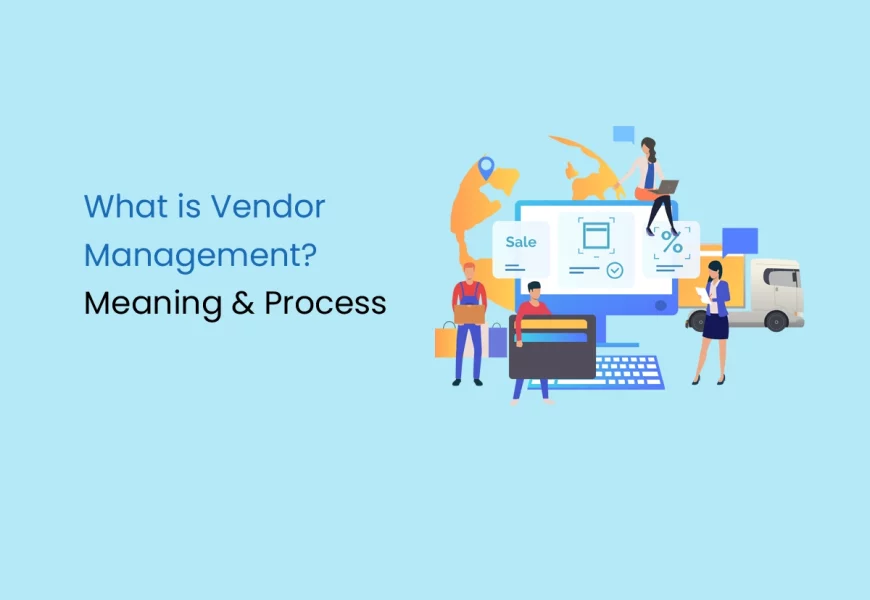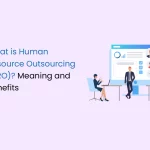Numerous companies maintain close partnerships with vendors to obtain the essential products and services needed to operate. The efficient management of these relationships is necessary for the organisation’s prosperity. To effectively oversee these partnerships, it is critical to have a comprehensive understanding of the entire vendor management process, including its various stages and actionable steps.
This article will discuss vendor management, its definition, importance, stages, and benefits.
What is Vendor Management?
Vendor management is the term used to describe the processes that organisations employ to oversee their suppliers, also known as vendors. These processes encompass activities such as vendor selection, contract negotiation, cost control, risk reduction, and ensuring service delivery.
The variety of vendors used by a company varies based on the nature of the organisation. It may encompass a wide range of businesses, such as seafood suppliers, IT vendors, cleaning services, and marketing consultants. Vendors may vary in size from sole proprietorships to large corporations.
Importance of Vendor Management
Vendor management is important for the following reasons:
- Vendor Selection: Vendor management is crucial for choosing the most suitable vendor to meet specific business requirements. Thorough evaluation and selection procedures guarantee that vendors align with the company’s objectives and needs.
- Achieving Business Goals: Vendor management is a valuable strategy for companies to seize cost-saving opportunities and boost operational efficiency. Additionally, it can streamline the onboarding process for new vendors, ensuring swift and seamless integration.
- Risk Reduction: Effectively managing vendors is crucial for minimising supply chain disruptions. It helps guarantee timely delivery and adherence to quality standards, thus sustaining operational continuity.
- Stronger Relationships: Establishing an efficient vendor management process is crucial for companies to enhance their partnerships with vendors. Cultivating strong relationships with vendors can provide opportunities to secure more favourable rates and terms, resulting in long-term advantages for both parties.
Benefits of Vendor Management
Here are the benefits of vendor management:
- Improved Vendor Selection: IVendor management incorporates clear business criteria and offers a centralised platform to compare supplier information. This process equips organisations with reliable data, enabling them to select the best vendors to meet their specific needs. Through vendor management, companies ensure that suppliers are aligned with their goals and requirements, ultimately leading to improved outcomes.
- Reduced Operational Costs: Managing suppliers manually can be time-consuming and labour-intensive. Vendor management can streamline the process by reducing the time spent on individual vendor-transaction lifecycles. It also helps track supplier performance against established service level agreements (SLAs), which can minimise additional recruiting and training costs while eliminating rogue spending. These advantages can improve productivity and reduce costs for both parties involved.
- Faster Vendor Onboarding: Proper vendor onboarding is crucial for maintaining productivity and controlling operational costs. Effective vendor management expedites onboarding by capturing and organising essential vendor information for swift and accurate supplier approval. This guarantees seamless and prompt integration of new vendors, minimising potential disruptions.
- Enhanced Reporting and Analytics: Implementing vendor management effectively consolidates all pertinent vendor information into a unified platform. This facilitates the organisation and oversight of vendors while also providing access to crucial process and operational data for analysis. Through advanced analytics and reporting features, businesses can more effectively identify and predict requirements, opportunities, and potential challenges, enabling them to make better-informed decisions.
- Decreased Risk: Vendor management allows businesses to store and review vendor performance, enabling them to address any inefficiencies, delays, and legal issues. Additionally, vendor management helps to ensure that all necessary paperwork is completed, approvals are obtained, and any changes or licensing requirements are communicated to the appropriate individuals. This process also creates a clear audit trail for accountability and future reference.
- Better Supplier Relationships: Efficiently managing vendors involves cultivating positive and productive working relationships. It entails maintaining comprehensive organisation and accessibility of vendor relationships for authorised personnel within the organisation. This approach allows for personalised management of vendors, ensuring that essential details are given the necessary attention, irrespective of the number of vendors the organisation engages with. Enhanced supplier relationships often result in more favourable negotiation outcomes, including better rates and terms.
Vendor Management Process
The vendor management process consists of the following steps:
Determine Needs and Responsibilities
Before finalising any contracts with suppliers, it’s essential to start the vendor management process by identifying the specific needs and objectives of the business. Once clear goals have been set, it’s important to define the requirements of the relevant business units, which may involve establishing a dedicated vendor management team. This approach facilitates complete adoption and minimises the potential for redundant efforts.
Select Vendors
It’s important to establish criteria for evaluating potential vendors when selecting vendors, considering both cost and non-cost factors. It’s essential to thoroughly assess any submitted proposals, considering the scope of work, pricing, renewal dates, and other essential factors. The evaluation process should be comprehensive to ensure the best chance of working with high-quality vendors.
Negotiate Contracts
In traditional practices, contract negotiation has typically been handled by legal, finance, and sales teams. The business units responsible for fulfilling the contracts were usually brought in after finalising the agreement. However, effective vendor management involves involving these units much earlier in the negotiation process, ensuring that all relevant stakeholders, including the procurement and supply chain teams, are included in the early decision-making stages. The specific goods and services to be provided during contract negotiation and the start and end dates are defined.
Onboard Vendors
Once negotiations are complete, it’s essential to establish approved supplier status for the selected vendors within the company systems. This involves gathering necessary documentation, securing approvals, and providing relevant details such as licenses, insurance information, and tax details. Proper onboarding is crucial for upholding compliance standards and ensuring the supplier receives appropriate payment for their services.
Maintain Ongoing Operations
It’s crucial to monitor vendor performance closely to manage business relationships effectively. Organisations can maintain consistency and reliability in their supply chains by regularly comparing their results with established Key Performance Indicators (KPIs) and promptly addressing potential issues.
Monitor Performance
Monitoring vendor performance is crucial for identifying potential risks that could harm an organisation. These risks may include data security vulnerabilities, legal issues, and non-compliance with regulations. Poor vendor performance can disrupt essential business operations and tarnish a company’s reputation, making this monitoring step an integral part of effective vendor management.
Close Out/Renew Contracts
As current contracts approach their expiration dates, effective vendor management involves following clear processes for either renewing these contracts or closing them out. Adhering to these processes is crucial to ensuring strict compliance and safeguarding the business’s interests.
What is a Vendor Management System?
A Vendor Management System (VMS) is a specialised software designed to streamline and modernise business vendor management procedures. Through VMS, businesses can efficiently address various aspects of vendor management:
- Identifying and choosing vendors
- Onboarding vendors into the system
- Tracking vendor deliveries using Purchase Requests (PRs), Purchase Orders (POs), Goods Received Notes (GRNs), and Invoices.
- Timely and accurate payments to vendors
- Reconciliation of payments with the company’s financial records
- Management of vendor contracts and other pertinent documents
VMS is just one component of the broader Source to Pay suite. The procurement process is intricate and expansive and involves various stages. Businesses can even customise software solutions to meet their distinct procurement needs.
Features of Vendor Management System
The following are the features of a vendor management system:
- Streamlined Onboarding of New Vendors: An advanced VMS streamlines the process of bringing new vendors on board by automatically gathering and validating essential documentation. This guarantees the accurate capture and storage of vendor details, simplifying the integration of new suppliers into the system and saving valuable time and resources.
- Centralised Contract Storage and Management: Centralised contract management in a VMS enables companies to store all vendor contracts securely in one location. This functionality simplifies contract retrieval, ensures adherence to contractual terms, and facilitates easy access to contract details for auditing and performance evaluations.
- Performance Tracking with Customizable KPIs: A VMS allows businesses to effectively monitor and assess vendor performance by utilising tailored KPIs. By establishing precise KPIs, organisations can continually evaluate vendor performance, pinpoint areas that require enhancement, and guarantee that vendors comply with pre-established benchmarks.
- Efficient Offboarding Process: Efficient offboarding processes in a VMS are essential for smoothly terminating vendor relationships when needed. This involves revoking access to company systems, settling any pending transactions, and securely archiving necessary documentation.
- Automated Workflows for Repetitive Tasks: Automating repetitive tasks like generating purchase orders, processing invoices, and creating reports, a VMS reduces manual workload, minimises errors, and accelerates transaction processing. This results in improved operational efficiency.
- Centralised Communication Platform with Vendors: Centralised communication capabilities can create a unified platform for all vendor interactions. This promotes reliable and coherent communication, streamlines issue resolution, and enhances collaboration between the company and its suppliers.
- Data Analysis and Reporting for Insights and Cost Savings: A VMS offers sophisticated data analysis and reporting features, allowing companies to obtain valuable insights into vendor performance and expenditure trends. These insights aid in recognising potential cost-saving opportunities, enhancing procurement strategies, and refining decision-making processes.
Essential Factors in a Vendor Management System
The factors to be considered while choosing a VMS are as follows:
- Cost Control: One of the main benefits of vendor management systems is the improved cost control they offer. This includes the ability to identify opportunities, eliminate redundant or unnecessary expenses, narrow down supplier options, and negotiate better rates.
- Benefits Realisation: The supplier relationship is established to achieve specific outcomes. Therefore, it’s crucial to consistently remember the provisions of the vendor contract to ensure that organisations can push their suppliers to fulfil their commitments. Additionally, implementing vendor management tools that streamline internal processes can assist businesses in reaching their objectives more efficiently and consistently.
- Supply Chain Resilience: Unexpected disruptions in the supply chain can lead to significant issues for organisations and vendors. Solutions for supply chain resilience help establish continuous communication with suppliers, enabling both parties to collaborate in identifying risks and planning for contingencies.
- Compliance Management: Regulatory standards are in place to ensure businesses prioritise their community’s well-being and safety. This involves offering high-quality products and services, maintaining honesty with customers and stakeholders, and promoting fair competition in the market. Compliance management is essential for keeping the organisation current and fully compliant with all applicable federal, state, and local regulations.
- Risk management: Organisations rely on risk management to identify and prioritise potential future events that could affect their business. By doing so, they can proactively minimise and control any anticipated negative consequences.
Vendor Management Challenges
Businesses can face the following challenges in vendor management:
- Centralised Vendor Visibility: Organisations with a diverse supplier base or dispersed across different locations often face challenges in obtaining a comprehensive overview of all their vendors. This lack of visibility can result in inefficiencies, redundant activities, and complexities in monitoring vendor performance and compliance.
- Documentation and Compliance: It can be challenging to ensure that vendors supply and update accurate documentation, including contracts, compliance certificates, insurance, and financial statements. Failure to manage documentation effectively can lead to compliance issues, legal risks, and operational disruptions.
- Risk Management: It’s important to dedicate time and resources to assessing and managing vendor risks, including financial instability, supply chain disruptions, and data security vulnerabilities. Failing to address these risks can significantly impact business continuity and reputation.
- Performance Monitoring and KPIs: Assessing and monitoring vendor performance in relation to Key Performance Indicators (KPIs) can be intricate, particularly when managing numerous vendors and varied contractual commitments. Inadequate performance can impact service provision and customer contentment.
- Communication and Collaboration: Effective communication and collaboration with vendors are crucial for addressing issues, negotiating contracts, and building strong relationships. When communication is lacking, it can result in misunderstandings, delays, and operational inefficiencies.
- Vendor Relationship Management: Building and maintaining productive vendor relationships requires continuous effort and proactive engagement. Neglecting relationship management can result in dissatisfaction, missed opportunities for collaboration, and difficulties in negotiating favourable terms.
- Scalability and Flexibility: Adapting vendor management practices to accommodate growth, organisational changes, and market dynamics requires flexible and scalable processes. Rigidity in vendor management frameworks can impede agility and responsiveness.
Conclusion
Effective vendor management goes beyond overseeing contracts and ensuring on-time deliveries. It involves establishing strong, mutually beneficial relationships that foster innovation, enhance quality, and cut costs. Businesses can nurture and uphold prosperous partnerships with vendors by prioritising transparent communication, shared objectives, trust, and ongoing improvement. Prioritising these relationships can result in substantial long-term advantages, rendering vendor management essential to a successful business strategy.
Frequently Asked Questions
What are the four stages of vendor management?
The four stages of vendor management are as follows:
- Segmentation
- Collaboration
- Implementation
- Evaluation
What are the types of vendor management?
The different types of vendor management are as follows:
- Procurement
- Vendor onboarding
- Vendor relationship management
- Vendor risk management
- Performance management
- Contract management
- Compliance management
- SLA management.
What is vendor relationship management?
Vendor relationship management facilitates effective communication between the buyer and vendor and fosters a more productive partnership.
What is vendor risk management?
Vendor risk management involves the assessment and control of potential risks that vendors may introduce to the effectiveness, security, or perception of the purchasing organisation. Vendors can bring inherent risks, like inadequate cybersecurity measures, operational challenges, or damaged reputations, and the vendor risk management process aims to identify these risks during the screening phase, thus preventing the organisation from entering into partnerships that could lead to future disruptions.
How does a vendor management system work?
Vendor management systems typically consolidate multiple functions, emphasising features that support information and relationship management.





















